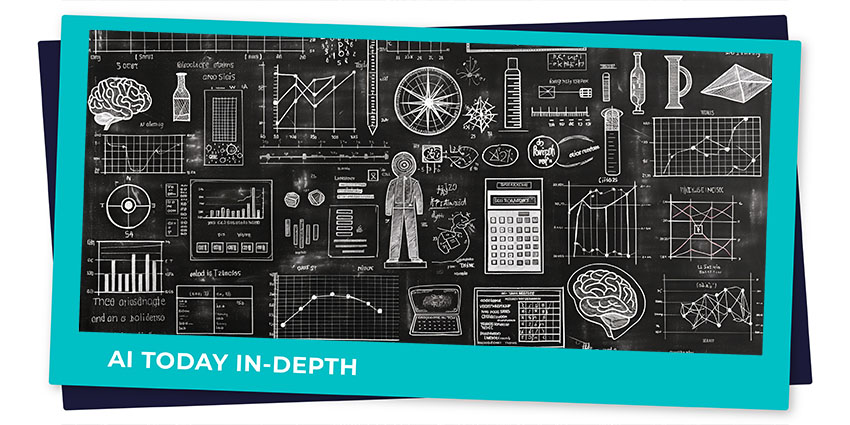In recent years in particular, AI has had a transformative impact on virtually every industry, influencing everything from product design, to marketing, and customer service. Similarly, artificial intelligence in education, could be the key to addressing countless challenges.
Already, the global AI in education market is growing at a phenomenal CAGR of 36%, highlighting just how impactful this technology can be. Used correctly, AI could optimize learning and teaching practices, improve student experiences, and more.
With artificial intelligence, students can receive personalized, always-on support as they expand their skills, and teachers can automate repetitive tasks, giving them more time for one-on-one interactions. However, as with AI in all industries, there are challenges to overcome.
Here’s your guide to the benefits, opportunities, and challenges of AI in education.
The Use Cases for Artificial Intelligence in Education
As new types of AI, such as generative AI and large language models continue to take the world by storm, the potential for this technology in education is growing. We’re still learning how AI technologies will integrate into the education sector in the years to come.
In the past, educators and school administrators may have relied on AI to simply streamline tasks, like assessing applications and managing student data. Now, however, there are endless opportunities to use AI to improve both student experiences, and teaching processes.
Just some of the most popular use cases, already being explored by educators in the UK and worldwide include:
Gamified Educational Experiences
Keeping students engaged, whether in a traditional school or college environment or in a workplace training setting, isn’t easy. Artificial intelligence can help with this. Solutions like Centrical allow educators to make training and learning fun with personalized competitions, dynamic leaderboards, rewards, and recognition.
AI can even detect student engagement levels and offer suggestions to educators on how to enhance their experience to boost participation rates.
Personalized, Adaptive Learning Platforms
One of the most significant use cases for artificial intelligence in education, is the ability to create more dynamic, personalized learning experiences for every student. Educational tech leaders like Carnegie Learning already offer access to adaptive platforms that can customize learning experiences in real-time. They identify the specific needs of students and adjust how content is written, delivered, and explained to boost knowledge retention.
Adaptive learning platforms could be particularly useful for enterprises training teams with different learning styles, or schools assisting those with learning difficulties. With the right solution, education doesn’t have to be a one-size-fits-all experience.
Advanced, Always-on Student Support
In many schools, universities, and other learning environments, chatbots and virtual assistants offer consistent feedback and support to students already. Simple chatbots can support learners by responding to admissions queries, or surfacing course information in an instant.
Other, more advanced chatbots, powered by generative AI can act as personalized tutors or study buddies. They can help students brainstorm ideas, suggest ways to improve their writing skills, or give them guidance on optimizing schedules. The Duolingo app already uses AI to deliver customized guidance to students as they learn new languages.
Automating the Work of Educators
Artificial intelligence in education doesn’t just deliver benefits to students. It can also streamline various repetitive tasks for educators. With AI systems, educators can put repetitive tasks like grading, planning, and administrative work on autopilot. This means teachers and trainers end up with more time to focus on supporting students.
AI can even help educators create intuitive course content, or assets for learning programs. Generative AI systems can design visual learning aids in seconds, or write introductions for courses. They can also help educators track down valuable resources for courses.
Supporting a Wider Range of Learners
Another major benefit of artificial intelligence in education, is the ability to customize courses and learning paths to suit different types of learners. We’ve already mentioned how AI can help personalize learning experiences. However, it can also make courses more accessible to those with learning, visual, or auditory disabilities.
Plus, it can help educators translate content into different languages for global students, allowing schools and training providers to deliver knowledge to people worldwide. Tools like Nuance can also transcribe content at incredible speeds, making it easier to deliver notes and written versions of workshops and classes to students.
The Benefits of Artificial Intelligence in Education
Based on the use cases outlined above, there are clearly numerous benefits to implementing cutting-edge AI into educational experiences. The most significant advantages include:
- Improved student experiences: With the ability to deliver personalized learning experiences, and 24/7 support using AI, educators can enhance student experiences. They can even significantly improve the chances of successful learning outcomes for each student.
- Enhanced engagement: With gamified experiences and even the opportunity to create immersive learning experiences with artificial intelligence and XR, educators can significantly boost student engagement and knowledge retention.
- Valuable insights: AI analytical tools can provide educators with valuable insights into student learning patterns and performance. This can help leaders identify areas for improvement, enhance curriculums, and tailor their instructional strategies.
- Boosted efficiency: Since AI is incredible at automating administrative tasks like scheduling and data management, it makes educational teams more efficient. It can help teachers and training professionals focus more of their attention on human interactions with students.
- Greater accessibility: By using AI to transcribe and translate content, create visual resources, and adapt courses to different learning requirements, educators can boost accessibility to education. They can even help students overcome disabilities and learning difficulties throughout courses.
The Challenges of Artificial Intelligence in Education
As mentioned above, while the potential for AI in education is phenomenal, there are still challenges to overcome. On a broad level, educators need to overcome hurdles related to:
- Technical expertise: Educators with limited technical expertise might struggle to adapt AI tools to their needs. Taking full advantage of this technology requires users to have a basic understanding of how to fine-tune and customize AI systems.
- Cost: Integrating artificial intelligence into educational processes can be expensive. Investing in the latest cutting-edge solutions, like large language models, wont be an option for every institution. Fortunately, some innovators in the tech landscape, are introducing more flexible platforms to help educators create AI solutions, for a lower cost.
- Quality concerns: For educators using AI to create content for courses and curriculums, quality is a concern. An over-reliance on intelligent tools could lead to a decline in the richness and quality of educational content. There’s even a risk that AI could generate incorrect information, based on limited data.
- Adoption: While 60% of educators already use AI in their classrooms, some are still reluctant to embrace this technology. Many are still concerned about the issue of job displacement, particularly as AI-powered tutors become more popular.
- Misuse: Many of the teachers concerned about the impact of artificial intelligence on education are worried about how this technology might be mis-used. For instance, students who use AI to generate reports and essays could miss out on learning opportunities, and end up plagiarizing the work of others.
- Security: Training AI models to deliver personalized experiences to students requires educators to share highly sensitive data with these systems. This raises security and ethical issues. Plus, if criminals gain access to AI systems, there’s a risk they could use them to steal sensitive information about students and teachers.
Governing Artificial Intelligence in Education
While there are many challenges to address before AI becomes “commonplace” in the educational space, the biggest risks are often associated with security, privacy, and ethics. As AI proliferates the educational landscape, many regulatory groups and communities are highlighting these concerns.
UNESCO, for instance, has introduced a mandate calling for a human-centric approach to AI, asking groups to ensure that they use AI ethically, and keep human beings in the training loop. UNESCO also developed a framework for the Beijing Consensus, focusing on highlighting governance policy recommendations to those using AI in the teaching landscape.
Elsewhere, the World Economic Forum also identified a series of pivotal transformations needed to enhance education quality in the era of AI. To ensure AI has a positive impact on both students and teachers alike, groups will need to focus on the following areas:
Data Governance and Security
All AI tools need to be trained on vast amounts of data to deliver the best results. In the education landscape, it will be crucial for educators and communities to ensure they’re implementing the right strategies to protect that data. Creating policies to determine which data is used to fine-tune AI, and what should be kept private will be crucial.
Additionally, educators will need to ensure the right safeguards are in place to protect them from cyber attacks and criminals that could steal sensitive information. Implementing security best practices will help to keep educators compliant in the age of AI.
AI and Digital Literacy
Many education systems are struggling to address the growing skills gap in the digital landscape. AI presents a powerful way to ensure students can improve their digital literacy, critical thinking, and problem-solving skills. However, before AI is implemented into any educational environment, leaders will need to ensure they’re educating users on how to use it safely.
Sharing clear insights into the benefits and potential risks of AI with students and teachers alike will help to minimize the risk of misuse. Educating users about the challenges and limitations of AI will also help to reduce over-reliance on these technologies.
Augmentation Over Replacement
Artificial intelligence in education is a powerful resource, but it will never replace human teachers and training experts completely. Educational groups implementing AI into learning, teaching, and research processes will need to focus on maintaining the right human and AI balance.
Ideally, artificial intelligence should be used primarily to support teachers, helping them to automate routine duties, and provide consistent feedback and guidance to students. They shouldn’t be used to completely replace educators, create entire course curriculums, or manage all aspects of human-teacher interaction.
Constant Assessment and Refinement
Even the most advanced AI systems can make mistakes. Leading technologies from Microsoft, Google, Amazon, IBM, and OpenAI aren’t foolproof. AI systems that share the wrong feedback or information with students can be extremely detrimental. They can facilitate the rise of misinformation and cause issues with learning outcomes.
Additionally, AI systems are also subject to bias, when they’re trained with incomplete or inconsistent data. This could lead to AI showing discrimination to certain students and teachers. Educators using AI will need to ensure they’re constantly reviewing system responses, and evaluating accuracy, to avoid negative outcomes.
Improving Education Accessibility
As mentioned above, one of the biggest benefits of artificial intelligence in education, is linked to how it can customize learning experiences for different students. Personalized learning experiences can contribute significantly to the success of all students. They also improve accessibility to information for people with learning difficulties and disabilities.
Educators should look at AI as a way to minimize current education gaps, with dynamic, adaptive learning experiences. However, they’ll need to be particularly cautious to ensure that training AI on the learning needs of different students doesn’t lead to accidental bias. This means collecting large amounts of data, and constantly fine-tuning models to improve outcomes.
The Future of Artificial Intelligence in Education
Implementing AI effectively into the educational landscape won’t be easy. However, it seems clear that demand for intelligent tools will continue to increase among educators and students alike. Fortunately, leading AI companies are already working to address the specific challenges and goals that educational institutions face.
Companies like Microsoft offer educators access to customizable AI solutions with Copilot Studio that can integrate into collaborative learning systems and tools like Microsoft Teams.
In 2024, OpenAI introduced a dedicated version of ChatGPT for the educational landscape. This solution provides access to greater security and privacy, and guarantees data won’t be used to train new models. Plus, it includes access to education-relevant features, like ability to build and share custom GPT models, or leverage document summarization tools.
In the future, we’ll see advancing solutions from various vendors paving the way to a brighter future for AI in education. Innovations in model design opportunities, as well as enhancements in natural language processing, data analytics and machine learning will continue to improve the landscape.
Plus, the rise of AI solutions in extended reality will lead to increasingly advanced immersive training and learning experiences. Educators will create custom tutors that work alongside students in immersive settings to provide real-time feedback and guidance.
While challenges still exist, the future of AI in education is bright.








